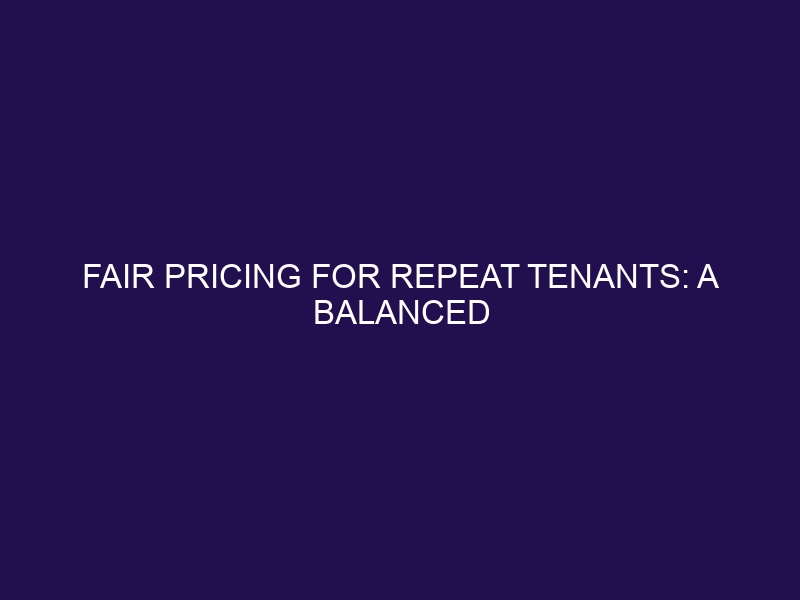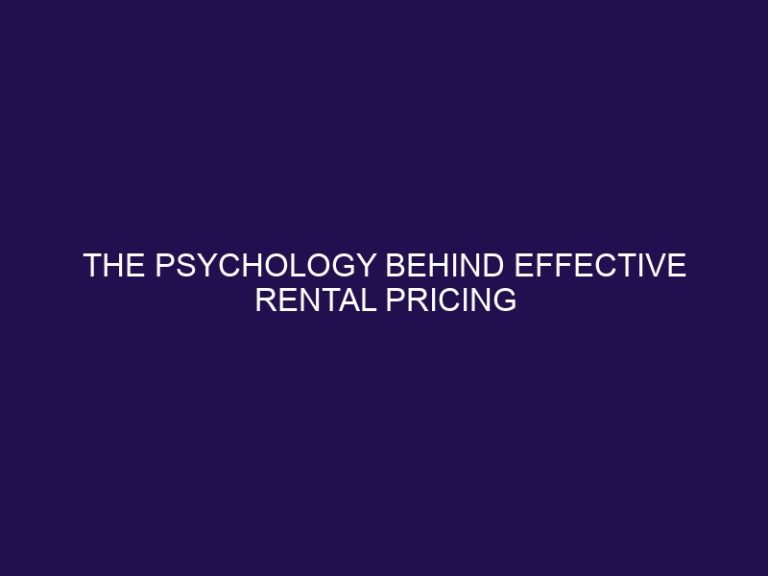Fair Pricing for Repeat Tenants: A Balanced Approach
Fair pricing for repeat tenants refers to the practice of setting reasonable and equitable rental rates for tenants who have continuously occupied a property for an extended period. This approach takes into consideration various factors such as market conditions, cost of living, and amenities provided, among others, to determine a fair and sustainable price for tenants.
Fair pricing for repeat tenants is essential for maintaining a positive and long-term landlord-tenant relationship. When tenants feel that they are being charged fairly, they are more likely to stay for an extended period, leading to a stable rental income for landlords. Additionally, fair pricing promotes a sense of trust and transparency, making tenants more likely to comply with rental policies and take better care of the property.
Several factors should be considered when determining fair pricing for repeat tenants, including market conditions, cost of living, amenities and services offered, and length of stay. Each of these factors plays a significant role in determining the fair value of a rental property and should be carefully evaluated before setting rental rates.
There are three main approaches to fair pricing for repeat tenants:
- Fixed Pricing Model: This model involves setting a fixed rental rate for an extended period, regardless of changes in market conditions or other external factors.
- Dynamic Pricing Model: This approach involves adjusting rental rates periodically based on market conditions, cost of living, and other factors that may affect rental value.
- Hybrid Pricing Model: This model combines elements of both the fixed and dynamic pricing models, offering a fixed rate for a specific period with the option to adjust it if necessary.
Each approach has its own pros and cons, and landlords must carefully consider which model is best suited for their rental property and tenants.
Landlords can strike a balance between fair pricing and profitability by conducting thorough market research, offering incentives for long-term tenants, and communicating openly with tenants about any changes in rental rates.
Some best practices for implementing fair pricing for repeat tenants include regularly reviewing and adjusting pricing, considering individual circumstances, and being transparent and fair in pricing policies. By following these practices, landlords can maintain a fair and sustainable rental pricing strategy for their tenants.
What Is Fair Pricing for Repeat Tenants?
What Is Fair Pricing for Repeat Tenants?
For repeat tenants, fair pricing involves striking a balance between competitive rates and rewarding loyalty. This can be achieved through discounted rent, exclusive amenities, or flexible lease terms. By consistently providing value and personalized incentives, tenant satisfaction is fostered and long-term commitments are encouraged.
Why Is Fair Pricing Important for Repeat Tenants?
Why Is Fair Pricing Important for Repeat Tenants?
Fair pricing is crucial for ensuring loyalty, trust, and long-term occupancy among repeat tenants. It fosters positive relationships between landlords and tenants and encourages tenants to renew leases, ultimately reducing turnover costs.
What Factors Should Be Considered When Determining Fair Pricing for Repeat Tenants?
When it comes to determining fair pricing for repeat tenants, there are several factors that must be taken into consideration. These factors can vary depending on the specific circumstances, but generally include market conditions, cost of living, amenities and services offered, and the length of stay. By examining each of these elements, we can gain a better understanding of how to approach fair pricing in a balanced and equitable manner for our valued repeat tenants.
1. Market Conditions
- Analyze market conditions for local rental demand and supply.
- Consider economic trends that may affect rental prices.
- Evaluate the pricing strategies of competitors in the market.
2. Cost of Living
Considering the cost of living is a crucial factor when determining fair pricing for repeat tenants. This involves analyzing local economic factors, inflation rates, and average expenses to ensure rental rates align with tenants’ financial capabilities.
A property manager in a metropolitan area adjusted rental rates annually based on the city’s cost of living index, fostering tenant loyalty and positive reviews.
3. Amenities and Services Offered
- Utilities: When considering a potential apartment, make sure to take into account the availability of electricity, water, and internet services.
- Facilities: It is important to evaluate the ease of access to amenities such as parking, laundry, gym, and recreational areas.
- Security: Take note of the presence of surveillance systems and secure entry points for added peace of mind.
- Maintenance: Look for on-site maintenance and timely resolution of any issues that may arise.
In the early 1900s, luxury apartment buildings in New York City went above and beyond to attract high society tenants by offering exclusive amenities such as grand lobbies, uniformed doormen, and private dining rooms.
4. Length of Stay
- Assess the duration of the tenant’s stay.
- Consider offering discounts for longer stays.
- Implement tiered pricing based on the length of stay.
Did you know? Offering discounts for longer stays can result in increased tenant retention and overall profitability.
What Are the Different Approaches to Fair Pricing for Repeat Tenants?
In the rental market, one of the key considerations for landlords is determining a fair pricing strategy for repeat tenants. There are various approaches that can be taken, each with their own advantages and limitations. In this section, we will delve into the three main pricing models: fixed, dynamic, and hybrid. By understanding the nuances of each approach, landlords can make informed decisions that strike a balance between fair pricing and maintaining a profitable business.
1. Fixed Pricing Model
- Determine a consistent rental rate for the entire lease period using a fixed pricing model.
- Set the price based on market analysis and cost considerations.
- Ensure transparency by clearly outlining the fixed pricing policy in the lease agreement.
2. Dynamic Pricing Model
- Utilizes real-time data to adjust pricing based on demand.
- Factors in market conditions, events, and tenant behavior.
- Allows for maximizing profits during peak periods.
- May lead to fluctuating rental income for landlords.
A property management company implemented a Dynamic Pricing Model and saw a 20% increase in revenue within six months due to optimized rental rates during high-demand periods.
3. Hybrid Pricing Model
- Combine Fixed and Dynamic Models
- Set base price and adjust based on demand and length of stay
- Utilize data analytics for pricing decisions
Hybrid models offer flexibility and revenue optimization, catering to tenant needs while maximizing profitability.
What Are the Pros and Cons of Each Approach?
When it comes to determining fair pricing for repeat tenants, there are a few approaches that landlords can take. Each approach has its own set of advantages and disadvantages that must be considered. In this section, we will delve into each approach – the fixed pricing model, the dynamic pricing model, and the hybrid pricing model – and analyze the pros and cons of each. By understanding the different factors at play, landlords can make an informed decision on which approach is best suited for their rental properties.
1. Fixed Pricing Model
- Implement a fixed pricing model for a specific period of time.
- Maintain consistent pricing across all leases.
- Regularly review and adjust rates to align with market trends.
Did you know? Fixed pricing models offer tenants stability and predictability in their rental costs.
2. Dynamic Pricing Model
The Dynamic Pricing Model is a flexible approach that adjusts rental rates according to demand, market trends, and other variable factors. This allows for maximum revenue during peak periods while also providing cost savings for tenants during off-peak times. Ultimately, this model strives to achieve a fair balance between profitability and tenant satisfaction.
3. Hybrid Pricing Model
- Combine fixed and dynamic pricing elements based on market demand.
- Adjust pricing periodically to reflect changing market conditions and tenant needs.
- Offer tiered pricing options to accommodate varying tenant preferences and budgets, utilizing a Hybrid Pricing Model.
How Can Landlords Strike a Balance Between Fair Pricing and Profitability?
As a landlord, finding the perfect balance between fair pricing for tenants and maintaining profitability can be a delicate task. However, it is not an impossible feat. In this section, we will discuss some effective strategies for striking this balance. From conducting market research to offering incentives for long-term tenants, there are various approaches that landlords can take to ensure both parties are satisfied. We will also emphasize the importance of open communication with tenants to foster a positive and mutually beneficial relationship.
1. Conduct Market Research
- Conduct market research to identify the target market and gather data on rental prices in the area.
- Analyze tenant preferences and demand for specific amenities or services.
- Examine occupancy rates and trends to understand market dynamics.
2. Offer Incentives for Long-term Tenants
- Provide reduced rent for lease renewals.
- Include complimentary services or amenities for long-term tenants.
- Offer incentives such as loyalty rewards, gift cards, or vouchers for extended stays.
3. Communicate Openly with Tenants
- Initiate Regular Communication: Schedule periodic check-ins to discuss their experience and address any concerns.
- Provide Transparency: Share any changes in pricing or policies openly, explaining the rationale behind such decisions.
- Seek Feedback: Encourage tenants to voice their opinions and suggestions regarding pricing and tenancy experience.
3. Communicate Openly with Tenants
What Are Some Best Practices for Implementing Fair Pricing for Repeat Tenants?
As a landlord or property manager, finding the right balance between fair pricing for your tenants and maximizing profits can be a challenge. In this section, we will discuss some best practices for implementing fair pricing for repeat tenants. By regularly reviewing and adjusting pricing, considering individual circumstances, and being transparent and fair in your pricing policies, you can create a balanced approach that benefits both your tenants and your business. Let’s dive in and explore these strategies in more detail.
1. Regularly Review and Adjust Pricing
- Analyze market trends and competition.
- Consider tenant feedback and economic changes.
- Adjust prices based on demand and property value.
To maintain tenant satisfaction, it is crucial to regularly review and adjust pricing. Landlords should stay updated on market trends, tenant needs, and economic shifts to ensure fair and competitive pricing for their properties.
2. Consider Individual Circumstances
- Assess tenant’s financial situation and stability.
- Consider their rental history and any special accommodation requirements.
- Evaluate their contribution to community or property well-being.
- Personalize pricing based on individual circumstances.
Fact: Tailoring rental prices to individual circumstances fosters tenant satisfaction and loyalty.
3. Be Transparent and Fair in Pricing Policies
- Regularly communicate pricing changes and factors affecting them to tenants.
- Provide a breakdown of costs and pricing rationale to ensure transparency and fairness.
- Allow tenants to offer feedback on pricing policies to address any concerns openly and fairly.
Frequently Asked Questions
What is the importance of effective communication in the landlord/tenant relationship?
Effective communication is crucial in maintaining a positive and amicable relationship between landlords and tenants. It helps avoid misunderstandings and conflicts, leading to a smoother and more enjoyable renting experience for both parties.
How can landlords ensure that necessary information is understood by tenants?
Landlords should be conscious of their communication methods and be flexible to accommodate their tenants’ preferred method. They should also be prepared to “over communicate” to ensure that their message is understood.
What are some common communication pitfalls that landlords and tenants should avoid?
Some common communication missteps include hanging up before the conversation is finished, not actively listening, and not expressing empathy towards the other person’s perspective. These can lead to strained relationships between renters, property managers, and landlords.
What are some tips for landlords to effectively communicate with their tenants?
Landlords should balance their role as experts with a desire to understand and help their tenants. They should be polite and clear when explaining things and take the time to answer any questions their tenants may have. If they don’t know the answer, they should offer to find it instead of getting flustered.
How can tenants communicate their needs and expectations to their landlords?
Tenants should be respectful and understanding when communicating with their landlords. They should clearly and accurately convey their needs and expectations and actively listen to their landlord’s expectations and responsibilities. This can help avoid misunderstandings in the future.
What role does Sweyer Property Management play in promoting effective communication between landlords and tenants?
Sweyer Property Management offers tips and advice for both landlords and tenants to avoid common communication pitfalls. They emphasize the importance of active listening, expressing empathy, and being flexible in communication methods to maintain a positive landlord/tenant relationship.







